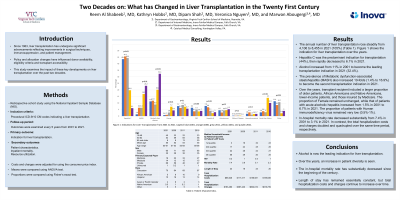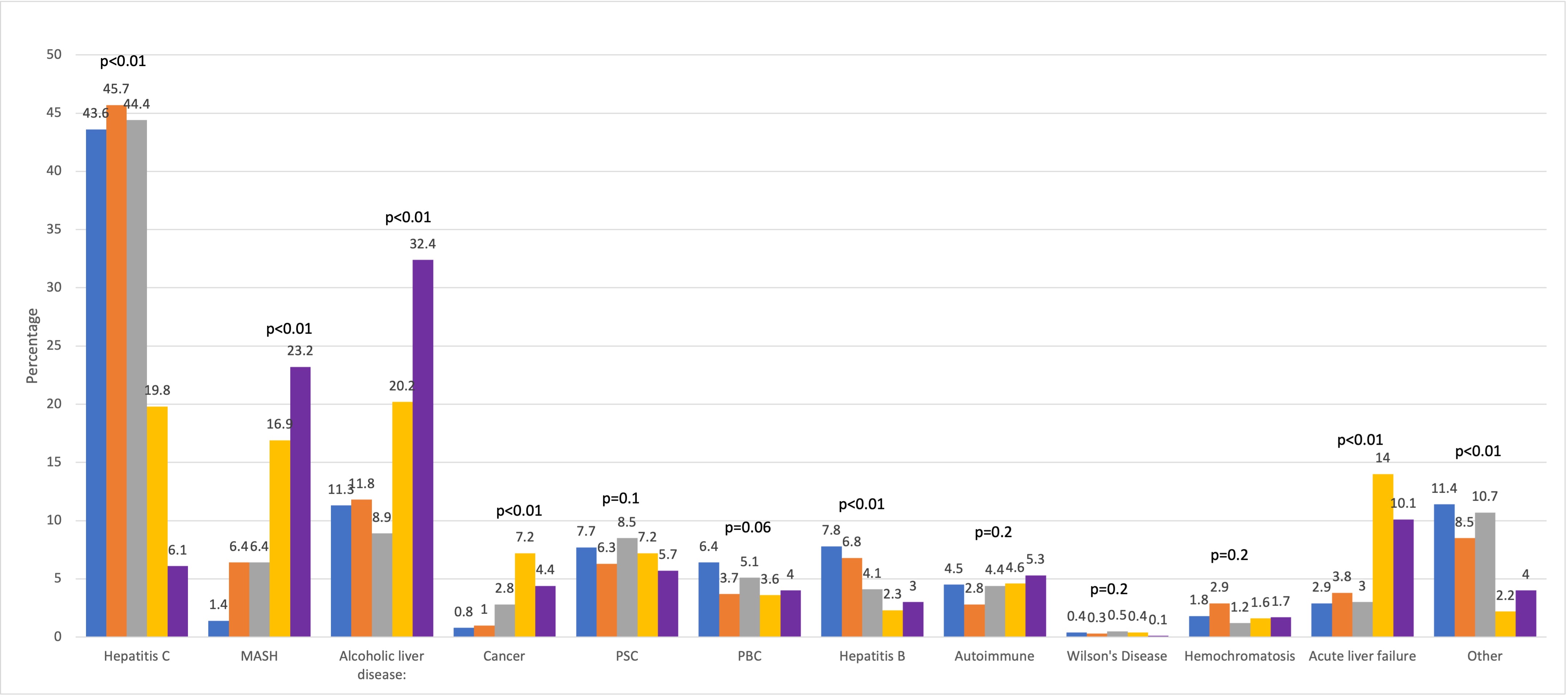Sunday Poster Session
Category: Liver
P1165 - Two Decades on: What Has Changed in Liver Transplantation in the Twenty First Century
Sunday, October 27, 2024
3:30 PM - 7:00 PM ET
Location: Exhibit Hall E

Has Audio

Reem Q. Al Shabeeb, MD
Inova Fairfax Medical Campus
Silver Spring, MD
Presenting Author(s)
Reem Q.. Al Shabeeb, MD1, Kathryn Hobbs, MD2, Dipam Shah, MD2, Veronica Nguyen, MD3, Marwan Abougergi, MD4
1Inova Fairfax Medical Campus, Silver Spring, MD; 2Inova Fairfax Medical Campus, Fairfax, VA; 3Inova Health System, Fairfax, VA; 4Inova Health System, Falls Church, PA
Introduction: Since 1963, liver transplantation has undergone significant advancements reflecting improvements in surgical techniques, immunosuppression, and patient management. Additionally, policy and allocation changes have influenced donor availability, eligibility criteria and transplant accessibility. This study examines the impact of these key developments on liver transplantation over the past two decades.
Methods: This is a retrospective cohort study using the national inpatient database. Outcomes were examined every 5 years from 2001 to 2021. Patients were identified using using procedural ICD-9/10 CM codes indicating a liver transplantation. The primary outcome was indication for liver transplantation. The secondary outcomes were patient’s characteristics, inpatient mortality and resource utilization. Costs and charges were adjusted for using the consumer price index. Means were compared using ANOVA test and proportions were compared using Fisher’s exact test.
Results: The annual number of liver transplantation rose steadily from 4,106 to 8,455 in 2021 (105%) (Table 1). 1 Figure 1 shows the indication for liver transplantation over the years.
Hepatitis C was the predominant indication for transplantation (44%), then rapidly decreased to 6.1% in 2021. In contrast, alcohol increased from 11% in 2001 to become the leading transplantation indication in 2021 (32.4%). The prevalence of Metabolic dysfunction-associated steatohepatitis (MASH) also increased 10-folds (1.4% to 16.9%) to become the second transplantation indication in 2021.
Over the years, transplant recipient included a larger proportion of older patients, African Americans and Native Americans, lower-income patients and those insured by Medicare. The proportion of Female remained unchanged, while that of patients with acute alcoholic hepatitis increased from 1.5% in 2001 to 6.7% in 2021. The proportion of patients with Human immunodeficiency virus remained very low (0.5%-1%). In-hospital mortality rate decreased substantially from 7.4% in 2001 to 3.1% in 2021. In contrast, the total hospitalization costs and charges doubled and quadrupled over the same time period, respectively
Discussion: Alcohol is now the leading indication for liver transplantation. Over the years, an increase in patient diversity is seen. The in-hospital mortality rate has substantially decreased since the beginning of the century. Length of stay has remained essentially constant, but total hospitalization costs and charges continue to increase over time.

Note: The table for this abstract can be viewed in the ePoster Gallery section of the ACG 2024 ePoster Site or in The American Journal of Gastroenterology's abstract supplement issue, both of which will be available starting October 27, 2024.
Disclosures:
Reem Q.. Al Shabeeb, MD1, Kathryn Hobbs, MD2, Dipam Shah, MD2, Veronica Nguyen, MD3, Marwan Abougergi, MD4. P1165 - Two Decades on: What Has Changed in Liver Transplantation in the Twenty First Century, ACG 2024 Annual Scientific Meeting Abstracts. Philadelphia, PA: American College of Gastroenterology.
1Inova Fairfax Medical Campus, Silver Spring, MD; 2Inova Fairfax Medical Campus, Fairfax, VA; 3Inova Health System, Fairfax, VA; 4Inova Health System, Falls Church, PA
Introduction: Since 1963, liver transplantation has undergone significant advancements reflecting improvements in surgical techniques, immunosuppression, and patient management. Additionally, policy and allocation changes have influenced donor availability, eligibility criteria and transplant accessibility. This study examines the impact of these key developments on liver transplantation over the past two decades.
Methods: This is a retrospective cohort study using the national inpatient database. Outcomes were examined every 5 years from 2001 to 2021. Patients were identified using using procedural ICD-9/10 CM codes indicating a liver transplantation. The primary outcome was indication for liver transplantation. The secondary outcomes were patient’s characteristics, inpatient mortality and resource utilization. Costs and charges were adjusted for using the consumer price index. Means were compared using ANOVA test and proportions were compared using Fisher’s exact test.
Results: The annual number of liver transplantation rose steadily from 4,106 to 8,455 in 2021 (105%) (Table 1). 1 Figure 1 shows the indication for liver transplantation over the years.
Hepatitis C was the predominant indication for transplantation (44%), then rapidly decreased to 6.1% in 2021. In contrast, alcohol increased from 11% in 2001 to become the leading transplantation indication in 2021 (32.4%). The prevalence of Metabolic dysfunction-associated steatohepatitis (MASH) also increased 10-folds (1.4% to 16.9%) to become the second transplantation indication in 2021.
Over the years, transplant recipient included a larger proportion of older patients, African Americans and Native Americans, lower-income patients and those insured by Medicare. The proportion of Female remained unchanged, while that of patients with acute alcoholic hepatitis increased from 1.5% in 2001 to 6.7% in 2021. The proportion of patients with Human immunodeficiency virus remained very low (0.5%-1%). In-hospital mortality rate decreased substantially from 7.4% in 2001 to 3.1% in 2021. In contrast, the total hospitalization costs and charges doubled and quadrupled over the same time period, respectively
Discussion: Alcohol is now the leading indication for liver transplantation. Over the years, an increase in patient diversity is seen. The in-hospital mortality rate has substantially decreased since the beginning of the century. Length of stay has remained essentially constant, but total hospitalization costs and charges continue to increase over time.

Figure: Indications for Liver Transplantation from 2001 to 2021. Legend: blue=2001, orange=2006, grey=2011, yellow=2016, and purple=2021.
Note: The table for this abstract can be viewed in the ePoster Gallery section of the ACG 2024 ePoster Site or in The American Journal of Gastroenterology's abstract supplement issue, both of which will be available starting October 27, 2024.
Disclosures:
Reem Al Shabeeb indicated no relevant financial relationships.
Kathryn Hobbs indicated no relevant financial relationships.
Dipam Shah indicated no relevant financial relationships.
Veronica Nguyen indicated no relevant financial relationships.
Marwan Abougergi indicated no relevant financial relationships.
Reem Q.. Al Shabeeb, MD1, Kathryn Hobbs, MD2, Dipam Shah, MD2, Veronica Nguyen, MD3, Marwan Abougergi, MD4. P1165 - Two Decades on: What Has Changed in Liver Transplantation in the Twenty First Century, ACG 2024 Annual Scientific Meeting Abstracts. Philadelphia, PA: American College of Gastroenterology.
